The $60 CPU Question: AMD Athlon 200GE or Intel Pentium Gold G5400? A Review
by Ian Cutress on January 14, 2019 8:00 AM ESTCPU Performance: Rendering Tests
Rendering is often a key target for processor workloads, lending itself to a professional environment. It comes in different formats as well, from 3D rendering through rasterization, such as games, or by ray tracing, and invokes the ability of the software to manage meshes, textures, collisions, aliasing, physics (in animations), and discarding unnecessary work. Most renderers offer CPU code paths, while a few use GPUs and select environments use FPGAs or dedicated ASICs. For big studios however, CPUs are still the hardware of choice.
All of our benchmark results can also be found in our benchmark engine, Bench.
Corona 1.3: Performance Render
An advanced performance based renderer for software such as 3ds Max and Cinema 4D, the Corona benchmark renders a generated scene as a standard under its 1.3 software version. Normally the GUI implementation of the benchmark shows the scene being built, and allows the user to upload the result as a ‘time to complete’.
We got in contact with the developer who gave us a command line version of the benchmark that does a direct output of results. Rather than reporting time, we report the average number of rays per second across six runs, as the performance scaling of a result per unit time is typically visually easier to understand.
The Corona benchmark website can be found at https://corona-renderer.com/benchmark
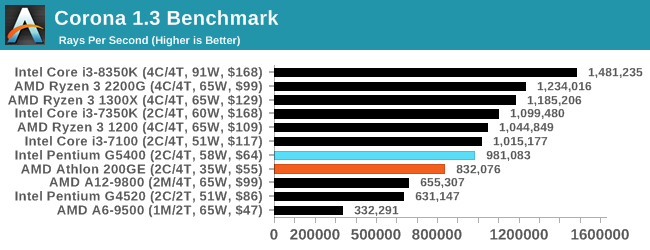
Corona is an all-threaded test, and Intel’s frequency advantage comes into play here with a 15% win.
Blender 2.79b: 3D Creation Suite
A high profile rendering tool, Blender is open-source allowing for massive amounts of configurability, and is used by a number of high-profile animation studios worldwide. The organization recently released a Blender benchmark package, a couple of weeks after we had narrowed our Blender test for our new suite, however their test can take over an hour. For our results, we run one of the sub-tests in that suite through the command line - a standard ‘bmw27’ scene in CPU only mode, and measure the time to complete the render.
Blender can be downloaded at https://www.blender.org/download/
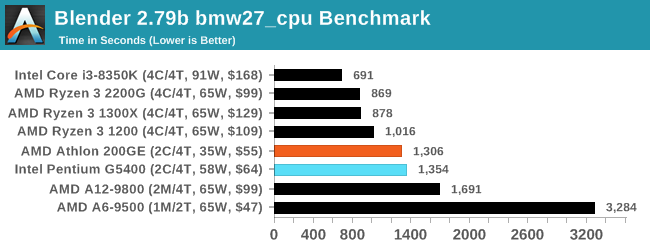
Blender also uses a mixed instruction workload, though not to the extent that our 3DPM and y-cruncher workloads do. But as with those tests, we get an AMD win of 3.7%.
LuxMark v3.1: LuxRender via Different Code Paths
As stated at the top, there are many different ways to process rendering data: CPU, GPU, Accelerator, and others. On top of that, there are many frameworks and APIs in which to program, depending on how the software will be used. LuxMark, a benchmark developed using the LuxRender engine, offers several different scenes and APIs.

Taken from the Linux Version of LuxMark
In our test, we run the simple ‘Ball’ scene on both the C++ and OpenCL code paths, but in CPU mode. This scene starts with a rough render and slowly improves the quality over two minutes, giving a final result in what is essentially an average ‘kilorays per second’.
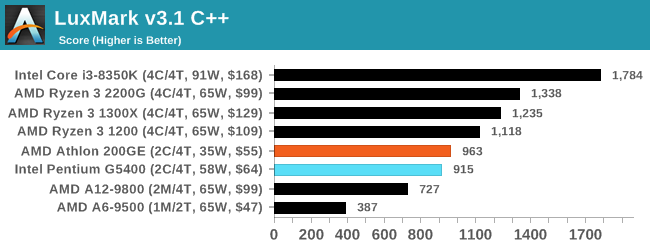
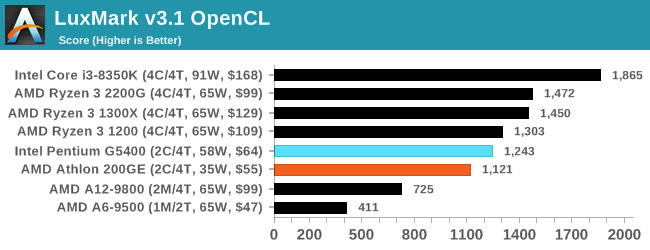
Interestingly we see AMD take the win for the C++ code by 5%, but Intel gets ahead with the OpenCL code (running purely on the CPU) by 10%.
POV-Ray 3.7.1: Ray Tracing
The Persistence of Vision ray tracing engine is another well-known benchmarking tool, which was in a state of relative hibernation until AMD released its Zen processors, to which suddenly both Intel and AMD were submitting code to the main branch of the open source project. For our test, we use the built-in benchmark for all-cores, called from the command line.
POV-Ray can be downloaded from http://www.povray.org/
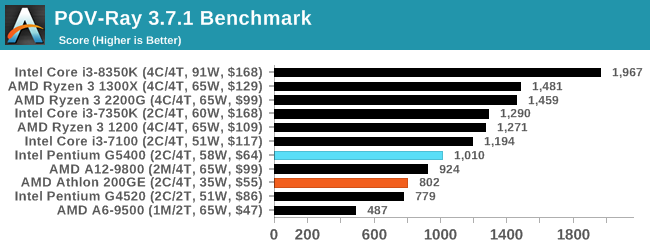
As another throughput test, here AMD is behind by 20%.











95 Comments
View All Comments
perdomot - Saturday, January 19, 2019 - link
How does the author of this article not know that the price of the G5400 is in the $120+ range? At that price, the 1300x would be the appropriate comparison and it clearly smokes the Intel cpu in the benches. The author needs a reprimand for this poor work.mito0815 - Thursday, January 24, 2019 - link
Oh ffs. Been a while since I was around, and OH WOULD YOU LOOK AT THAT, the AMD shilling and -fanboyism in the comments has become just as unbearable as I'd imagined. People, he set up two budget CPUs on a comparable level (AMD strong in GPU, Intel a tad bit stronger in CPU performance & clock) against each other...nothing more, nothing less. Store prices for Intel CPU's being so inflated isn't really Intel's fault now, is it? The intended stock prices are still very much comparable. By your logic, AMD would've not been quite the price/performance god you all worship during the mining GPU price explosion now, would it?But no, all you guys want is an article with some AMD CPU coming out on top, no matter how it's done. Get over yourselves. By the looks of it, while GPU is still a sore point with AMD, Ryzen 2 seems to look good so far. Wait for that and don't go all rampant now.
kkilobyte - Saturday, January 26, 2019 - link
The article title starting with: "The $60 CPU question", it is not unreasonable 'fanboi-ism' to expect that the article is comparing CPUs costing, well, around $60.And the issue is not about Intel being guilty or not of the current high prices.
The problem is that the article draws conclusions that simply don't match reality, precisely because it doesn't adress the current discrepancy between the street prices and the manufacturer's suggested one. It would have taken a single paragraph to explain that.
My issue about the article is that, unlike what you are writing, it doesn't compare CPUs of similar (price) level. What it does is comparing CPUs of similar *theorical* price levels, but draws a conclusion as if those were the commonly seen street prices. This is dishonest and misleading.
watersb - Saturday, February 9, 2019 - link
Thanks for this review. I usually build low-end systems (PCs for family members), buy off-lease enterprise stuff (test servers), or used Apple or Lenovo gear (rebuilds and workstation projects).Budget gamng gear for the kids, then help them upgrade graohics card later, seems to be the one remaining path to "gaming enthusiast" hobby.
Everyone else gets a Chromebook. And a Raspberry Pi.
Dr Hasan - Tuesday, November 26, 2019 - link
Why are all products are old and prices too. Athlon 3000g is 50$ rayzen 2200g is less than 100$